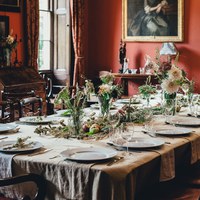Prairie Fare: Do you know the steps to setting a formal table?
(Click an image below to view a high-resolution image that can be downloaded)
I had the chance to visit a late-1800s mansion recently. This “summer home” was only used a couple months out of the year. Its upkeep required 40 servants to take care of the interior of the home and the yard along a seashore.
If I were lucky, I probably would have been one of the European-immigrant servants for this extremely wealthy family. I would not have enjoyed polishing the silverware or dusting the intricately carved woodwork. I would have liked cooking or setting the table.
We didn’t get to see the servant rooms. They were probably housed in the attic.
In a way, visiting such opulence was like traveling back in time. I looked around the gymnasium-sized kitchen and dining room with elaborate drapes, carved furniture and ceilings with gold accents painted by artists.
I imagine five-course meals with formal place settings were the standard at that time. I am sure they dressed in all their finery for dinners, probably helped by servants.
I have taken my kids to culinary schools that serve multiple-course meals. I wanted them to know table etiquette when enjoying meals that might be fancier than a typical homemade meal.
I remember my daughters stared at me, looking for cues when confronted with so many utensils. I was on my best behavior at the culinary school because kids usually follow your actions more than your words.
1. What do you do when confronted with multiple utensils on each side of the plate at a formal wedding or banquet? Let’s take a little quiz. You have been asked to set the table for a casual meal that will use a napkin, plate, fork, spoon and knife. What order from left to right is usually suggested?
- Knife with blade away from plate, plate, fork, spoon, napkin.
- Napkin, knife with blade toward plate, spoon, plate, knife.
- Fork on top or next to napkin, plate, knife with blade toward plate, spoon.
2. You are setting the table for a meal that includes a salad and a soup course. Where do the salad fork and soup spoon go?
- Salad fork to the left of the dinner fork and soup spoon to the right of the dinner spoon.
- Salad fork and soup spoon above the plate.
- Salad fork goes on top of the salad plate and soup spoon goes in the soup bowl.
3. How do you signal you are done eating a course of food?
- Put your utensils in a criss-cross pattern across your plate.
- Put your utensils parallel across your plate.
- Put your used utensils on your napkin.
4. Where does the water glass go in a formal setting?
- At the tip of the fork.
- Above the plate.
- At the tip of the knife.
5. In general, what is the best way to approach a place setting with multiple courses and multiple utensils?
- Use the utensils above the plate first.
- Use the utensils closest to the plate first.
- Use the utensils farthest away from the plate first and move toward the plate.
Answers: 1.c; 2. a; 3. b. Criss-crossing your utensils on the plate signals you are taking a break from eating; 4. c. If wine is served with the meal, the glass is placed to the right of the water glass; 5. c.
In a formal meal, a separate dessert spoon, by the way, would be placed above the dinner plate. Here’s a no-bake dessert recipe featuring berries. Regardless of how you incorporate them into meals, berries of all types are high in natural antioxidants that can support immune health and heart health.
No-Bake Mixed-Berry Cheesecake Cups
2 ¼ cups berries
6 tablespoons sugar, divided
2 tablespoons water
½ small lime or 1 tablespoon lime juice, more to taste
½ cup heavy cream, well chilled
8 ounces reduced-fat cream cheese, at room temperature
2 tablespoons honey
1 ½ teaspoons vanilla extract
12 ounces berries (your choice, for topping)
8 (4-ounce) clear cups
Jam: Place 1 ½ cups of preferred berry in a saucepan, and add 3 tablespoons of sugar and 2 tablespoons of water. Stir over medium heat. Bring mixture to a boil, stirring occasionally, and when berries begin popping, stir more frequently until the jam begins to thicken (about 15 minutes). Scrape the jam into a medium bowl, add lime juice and stir. Taste and add more lime juice if you prefer. Stir in ¾ cup of the remaining berries and set the bowl aside to cool.
Once the jam mixture has cooled, divide it among cups.
Cheesecake: With an electric mixer, beat heavy cream until it holds medium peaks and put it to the side (about 5 minutes). In a separate bowl, beat cream cheese until smooth. Add 3 tablespoons sugar and 2 tablespoons of honey and continue to beat until mixed well. Mix in vanilla. Using a spatula or spoon, fold the whipped heavy cream into the cream cheese mixture. Spoon the cheesecake mixture over the jam, and divide evenly among the 8 cups. Cover and chill cups for at least 3 hours.
Topping: After the cups have chilled, place the remaining berries into a large bowl and mix. Spoon berries over the cheesecake cups and refrigerate until ready to serve.
Makes eight (4-ounce) servings. Each serving has 170 calories, 9 grams (g) fat, 2 g protein, 21 g carbohydrate, 2 g fiber and 75 milligrams sodium.
(Julie Garden-Robinson, Ph.D., R.D., L.R.D., is a North Dakota State University Extension food and nutrition specialist and professor in the Department of Health, Nutrition and Exercise Sciences.)
NDSU Agriculture Communication – Oct. 5, 2023
Source: Julie Garden-Robinson, 701-231-7187, julie.garden-robinson@ndsu.edu
Editor: Elizabeth Cronin, 701-231-7881, elizabeth.cronin@ndsu.edu




